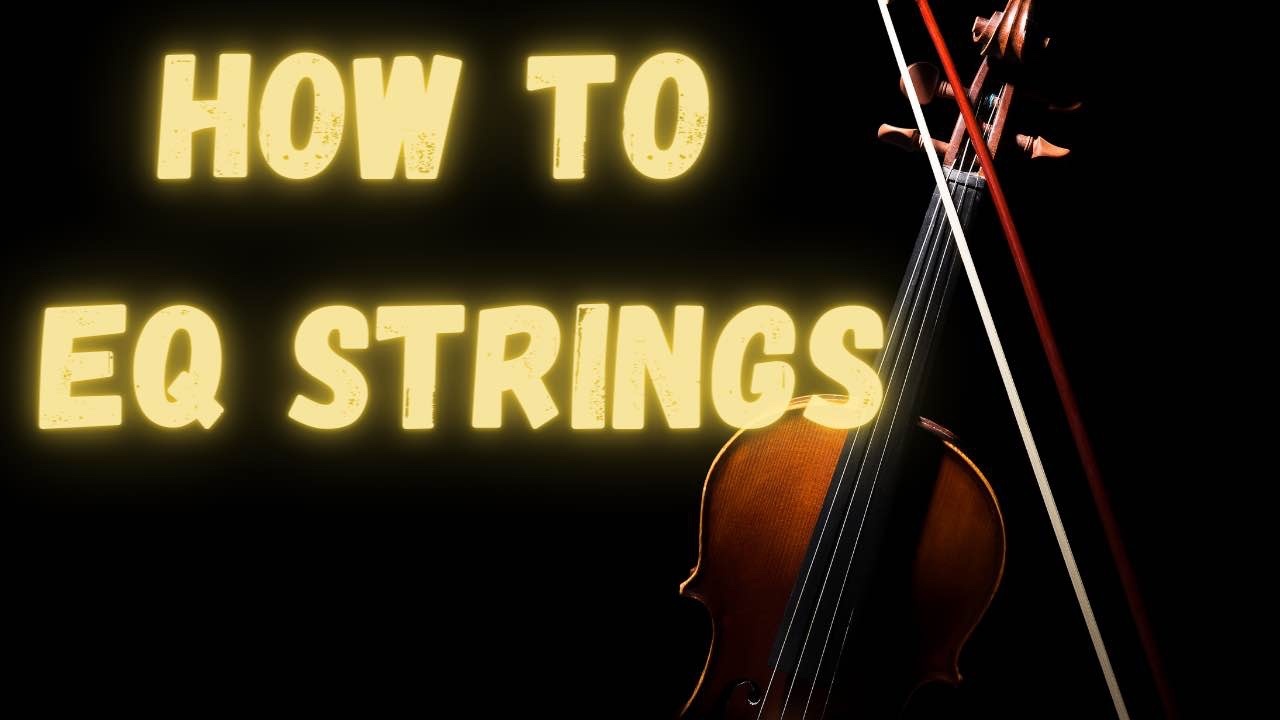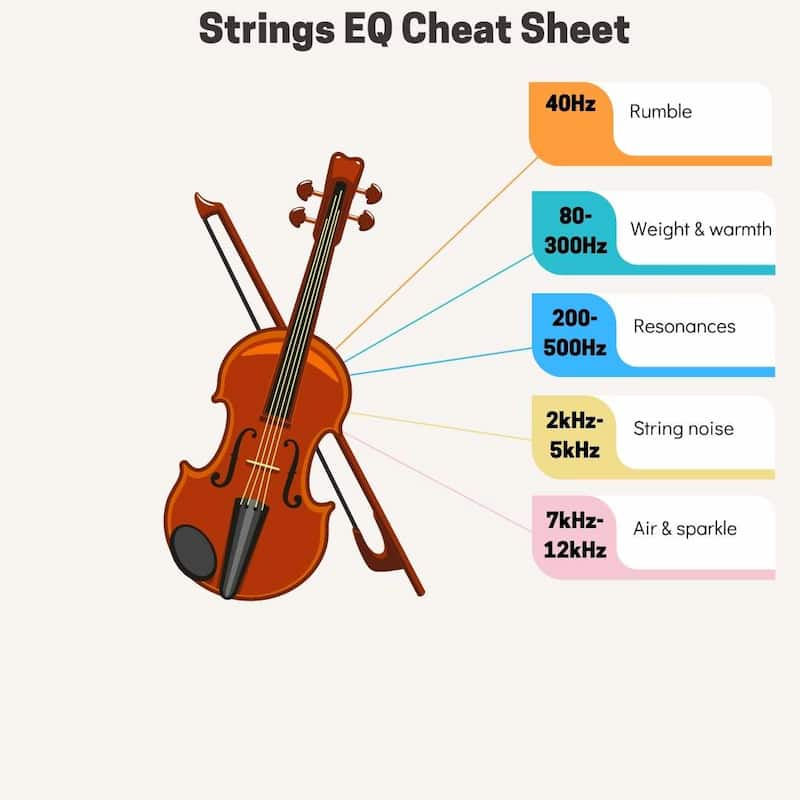How to EQ Strings

One of my absolute favorite instruments for adding the final touches to my productions is strings. However, getting strings to fit well in a mix, let alone with each other, can be a bit of a challenge.
And, of course, the way in which we EQ strings can change drastically from one mix to the next.
In a classical mix, for example, you might want to leave everything sounding as natural as possible, focusing more on the placement of strings with pan knobs and the tone of the room during the recording phase.
However, in a pop mix, strings might not need to take up a fair portion of the frequency spectrum.
In this article, we’re going to dive in and give you the fundamental frequencies to look for when EQing strings in your mix and give you some of my best tips from my book 📗 How to Mix with EQ 📗.
Note: this article may contain affiliate links, which mean that I receive a commission for any purchases you make, at no added cost to you.
What Makes EQing Strings Challenging?
Before we dive in, let’s tackle the question,
What makes EQing strings so challenging?
From top to bottom, strings have A LOT of frequency content. In higher strings, such as violin and viola, you often get tons of top-end that can stick out of a mix if you’re not careful. With cellos and bass, you get tons of boomy, low-end frequency content that can muddy up your mixes and take away precious clarity.
In essence, you’ll have to mix different types of stings differently, scooping the mud out of low-end heavy strings while retaining warmth and getting rid of harsh high frequencies in high-end strings while retaining a sense of brilliance.
When you’re dealing with room sounds that aren’t that great, the process can become even more challenging. You’ll often have to sweep around to get rid of ugly room resonances without ruining the overall integrity of the sound.

How to EQ String Bass
Bass frequencies require a fair amount of power. If you’re unable to tame them, they can eat up the headroom in your track. Plus, untamed bass frequencies can make your mixes sound muddy and disproportionate.
For EQ string bass, the most important frequency range is from 40 to 200 Hz. You want to make sure that the frequencies here have their own space.
You can often roll off the low-end below 32Hz without causing any problems and getting rid of the necessary low-end. Most stereo systems won’t be able to produce frequencies below 32Hz anyway, so you won’t substantially affect the tone of the bass.
If you need to increase or decrease the “weighty” part of the bass, then look to boost or cut in the 80 to 100Hz range. If your bass is sounding a bit boomy, you might consider cutting between 100 to 150Hz. Lastly, if your bass is lacking warmth, you can typically add in a slight, wide boost anywhere from 100 to 300Hz.
If you realize that your string bass needs a bit more attack, look in the 500Hz to 1.5kHz region. In doing so, you’ll increase the presence of your bass. Just make sure not to overshadow the other strings in your mix.
How to EQ Cello
Starting with the low-end, you’ll typically want to get rid of any rumble that sits from 0 to 80Hz. Of course, if the cello is acting as the bass in your mix, you might consider leaving in that low-end. However, if you already have another instrument in your mix that is acting as the foundation, it’s typically a good idea to high-pass this information out to make room in your mix.
When checking for mud, I typically like to look between 200 and 300Hz. A narrow Q with your cello EQ is best to get rid of problematic frequencies that continuously arise throughout the song. However, be careful not to cut out the fundamentals of specific notes with too narrow of a Q.
For warmth and fullness, look in the 400 to 600Hz range. Boosting with a wide Q here can give your cello a rounder, fuller sound. However, a bit too much in this range can start to strip clarity away from your bass.
If your cello needs a bit of added presence and definition, look between 6 to 8kHz. A small boost here can help bring out the sound of the bow on the strings. Along with this kind of boost, I’ll sometimes low-pass down to around 14-15kHz to get rid of top-end harshness if necessary. Doing so can give your cello a more distant timbre.
How to EQ Viola
In most mixes, viola won’t need tons of low-end. You can typically high-pass up to about 100Hz without ruining the integrity of the instrument. If your viola is in a mix with other string instruments, it’s a good idea to check for mud in the 150 to 240 Hz range.
However, if your viola is in a sparser mix where it needs fullness, you can typically boost a bit here.
Depending on the mix, I might want to add some bow noise to my viola. In this case, I’ll boost around 2.4 to 4kHz. If you want to enhance the attack of your viola, you can boost anywhere from 500-1kHz. On the other hand, if the attack is too strong, you can reduce the range to soften it up.

How to EQ Violin
You can treat violins the same way as violas in many instances. For example, you often don’t need a lot of low-end in a violin track. Most of the frequency content below 100Hz is just rumble. I’ll usually treat my violin with a high-pass filter to get rid of that rumble.
In a dense mix, I’ll also often want to tame the low-mids, meaning a cut anywhere from 100-250Hz. On the other hand, if you’re dealing with a solo violin, you might want a bit more fullness to fill out the frequency spectrum. Instead of boosting from 100-250Hz, I typically like to boost around 200-350Hz. In this case, I’ll often use wide Q values.
In many solo violin tracks, I’ll also boost anywhere from 2.4kHz to 7kHz to get a bit of added string noise. To me, this brings out the dynamics and emotion of the player. I’ll sometimes even boost around 7-10kHz if I want a bit more scratchiness in my mix.
How to EQ String Section
If you don’t have the luxury of EQing individual string instruments, you’ll have to be a bit more cautious with your EQ approach.
For low-end, I’ll often high-pass up to 40Hz for strings sections, as most of this range is unnecessary rumble. You can often find a bit more weight and warmth from 80 to 300Hz, though I’ll also often make small cuts between 200 to 500Hz with narrow Q values to get rid of resonant peaks.
Attack usually lies in the 500Hz to 1kHz range, which you can boost for presence or attenuate for softness. If the mix calls for it, bringing a bit of 2 to 5kHz out to get some additional string noise can be nice.
Lastly, more often than not, I’ll add a high-shelf above anywhere from 7kHz to 12kHz for a bit of added air and sparkle overall. Boosting here is a great way to get that expensive string section sound.
How to use EQ Guides
To help you get the most out of your EQ plugins, we've put together these detailed guides to teach you how to use EQ on some of the most popular instruments.
From a Frustrated Producer in a Ragtag Bedroom Studio to Major Placements on TV Earning $1,000s!
My name is Evan, and I've been making music since around 3rd grade. I'm from San Diego, California, but I've lived in Washington, DC for the last 20 years.
While I still have a full-time day job, I have created systems that have allowed me to produce dozens of songs a year in my spare time.
My songs have been on Netflix, TV shows like the 90 Day Fiance, an award-winning indie film, and NPR’s “All Thing Considered.” They've also been streamed millions of times.
In addition to being a music producer, I am passionate about teaching people how they can make professional-sounding music and earn money licensing it, all in their spare time.
Thousands of musicians, like yourself, have trusted me to guide their musical journey. My YouTube videos have been watched nearly a million times. And my story has been in Forbes, Side Hustle Nation, and the Side Hustle School.






